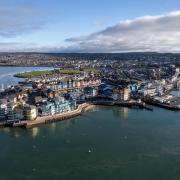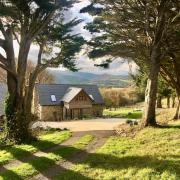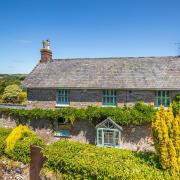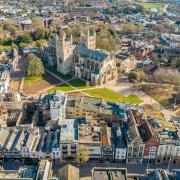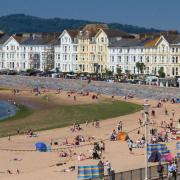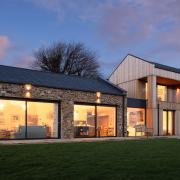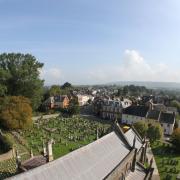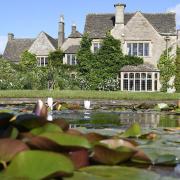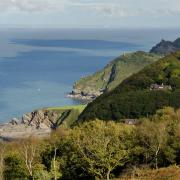What’s it like to live along a Devon road that will flood when the tide is high?

Millie and Henry’s mud-spattered bare feet patter across the stepping stones as the tributary gently babbles just inches below. The stream the young siblings are crossing outside their picturesque family home cuts through a marsh, which can partly or wholly disappear when the River Avon swells at high tide.
To flood the marsh, the river engulfs the adjacent tidal road, a short stretch of highway in Aveton Gifford that has been a brushstroke alongside the Avon for centuries.
And it’s not the only thing that can get submerged.
“At least when the house floods, the water has been filtered through the ground so you know it’s clean,” remarks the children’s grandmother Cedar Dickey, whose late father Henry Russell-Smith bought the house in 1985 when he retired.

“And it’s tidal here, so you know it will go away again. Flooding in an urban area would be much worse as it comes up through the drains.”
Nine family members - across four generations - currently live in the house, and Cedar, along with her daughter Pandora (Millie and Henry’s mother) and son James, animatedly describe the well-defined plan of moving belongings and traversing the kitchen on chairs should the Avon breach the threshold.
“My parents had these amazing, handmade carpets which they would take up after a flood and send them away to be professionally dried, but after daddy died we decided to go for hard floors,” Cedar adds. As a result any floods –, which only impact the original part of the house and not its elevated extensions – are cleaned up in hours.
Pandora and James recall a storybook childhood of countless hours on the river, removing trousers and shoes to get home after walks if the tide was too high, and a menagerie of pets including alpacas.

The joy of living on this stretch of water has actually been chronicled in Plot 29, a memoir by a former resident of the Dickey house, the Observer Food Monthly editor Allan Jenkins.
Then known as Peter Drabble, a change made using his middle name and the surname of his adoptive parents Lilian and Dudley, he recalls with fondness his childhood during the late 1950s and 1960s in the riverside cottage.
Are these the 11 prettiest villages in Devon?

Ros Brousson, an Aveton Gifford resident, lived on the tidal road for 23 years until 2016, bringing her children up next door to Cedar Dickey.
Although closer to the river, her former home sits atop a bump in the road that prevented it from flooding in her family’s time there. “Whoever built it there chose well,” she remarks.
“When the tide came in, it was like being on your own little island with no traffic at all. It was wonderful and the children used to play in dinghies and canoes on the river.”

She says her former home appears in watercolour paintings from the early 19th Century, and that back then, the river was different. The water was deeper and livelier, covering the nature reserve now known as South Efford Marsh.
Avon Dam’s construction in the late 1920s slowed the pace of water coming off Dartmoor, meaning the river bed shifted less, leading it to become shallower over time, and increasing flood risk.
Relatively new tidal road resident Zoe, who moved in March last year from elsewhere in the village, has already experienced the Avon’s waters lapping at her bungalow’s exterior wall as the tide seeped through her garden perimeter.
But when she saw the house up for sale, it was a no-brainer even though access is only by footpath at high tide rather than the lane the other houses can use.
“It had been owned by a family who I thought would never sell it, as they inherited it from their aunt, who had lived here from the word go,” she says. “The location is wonderful, the wildlife too, and we enjoy Canadian canoeing on the river. It’s beautiful.”
The lockdown-induced traffic hiatus has raised thoughts of how cars (which chance their luck at high tide and get stranded more often than you would think) and people can better share the route.
“We’ve got grandchildren and there are lots of little ones in the village,” says Zoe. “It should be properly dual purpose.”
Nevertheless, “the benefits far outweigh the disadvantages,” muses Cedar, as her grandchildren run back home, with muddy feet but without a care in the world.
The tidal road at Aveton Gifford has “been there since time immemorial,” according to Ros Brousson, a tidal road resident for more than two decades before moving elsewhere in Aveton Gifford.
A keen historian, Ms Brousson states that church records from 1420 show the Bishop of Exeter trying to raise money for a causeway south across the river, so travellers could avoid the tidal road and get between Kingsbridge and Modbury quicker. The causeway – now part of the A379 Kingsbridge road - was built but the tidal road remained a pivotal and majestic byway.
Hints of its industrious past are still evident, most visibly so through the lime kiln at the Bigbury end.
In the late 18th to early 19th Century, barges would have brought limestone to the tidal road, where it would have been offloaded and burned in kilns to be used as fertiliser for fields or mortar for housebuilding.
John Ashton, an Aveton Gifford-based artist, has a bursting photographic chronicle collated over 20 years of birds on the tidal road and across the river at South Efford Marsh, a nature reserve managed by the Devon Wildlife Trust since 2011.
His excitement is palpable when he reels off the species of birds he has spotted over the years, from little egrets and cattle egrets, to spoonbills and squacco herons, ospreys and even a lesser yellowlegs “which had never been here before”.
The beauty of the creatures is also expertly captured in his stunning paintings.
“Most birds here are migratory, and we get quite a lot of rare waders that come over winter and are increasing year by year,” he says. “But what’s great is you don’t get huge flocks of everything, so you can actually see what the birds do.”
Have you joined the Devon Life Facebook page yet?




